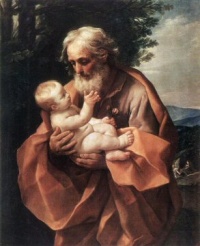Symbols of Saint Joseph
A symbol represents something else universally agreed upon. The
symbol can be a picture, sketch or painting such as firefighter
spraying water on flames at a fire scene. This image could represent
bravery of the firefighting profession, or it could represent
the danger of flames, or it could represent the result of carelessness
--- any number of universally agreed upon themes. The point is
that the full picture can represent a single concept --- a fire
scene—or a number of underlying concepts, all at the same
time. So it is with Saint Joseph symbols. Anything that can be
experienced by the seven senses, such as: books, music, foods,
and all symbols that can be physically experienced. There is another
type of symbol, the non-material symbol such: as ideas, themes,
concepts, abstract thoughts, etc. This type of St. Joseph symbol
is very popular, probably more so than the material symbols.
Symbols in Saint Joseph Art:
The famous painting of the Wedding of Virgin Mary and St. Joseph has three symbols:
- Obedience to God - the greatest is obedience to God’s instruction through an angel that he should wed Mary.
- Courage - The second symbol for St. Joseph in the painting is courage in the face of possible public opposition and oppression.
- Non-judgmental - St. Joseph symbol in the painting is the practice of not judging and condemning others.
Hang this Saint Joseph reproduction painting in the home and capture this symbolism and so much more.
Another famous painting of St. Joseph in art is the world renown, Nativity scene: Jesus in the manger with Mary and Joseph looking on. Here the presence of St. Joseph in the painting is also a symbol in three ways:
- First - he demonstrates civil obedience by responding to the census request of the government.
- Second - he demonstrates humility by accepting the stable as accommodation for pregnant Mary rather than causing a public disruption in the belief they were entitled to better.
- Third - he demonstrates steadfastness in honoring his marriage vows, seeing the pregnancy through to completion and accepting the new challenge of fatherhood.
St. Joseph icons and Holy Family icons are very popular and come in a variety of forms. Most commonly, these are flat panel paintings and less common are paintings cast in some fashion, such as on metal and on stone. Paper printed page is very common, while works of St. Joseph icons on cloth are increasingly popular worldwide. Likewise, pictures of St. Joseph are varied and plentiful.
Two of the most popular are St. Joseph full body standing holding a few lilies that are known to be symbols of his virtue and his holiness, and further, a picture of a youthful Jesus, with St. Joseph standing immediately behind and to the right of Jesus.
Saint Joseph picture books come in a variety of sizes, some with great detail, others less detailed. The picture books usually cover his life chronologically, but there are exceptions. A person can get an additional perspective of a given picture while idling through the pictorial of Saint Joseph’s life.
There are a number of wood carvings out there; however, three are known throughout the Christian world.
 |
- One is a depiction of St. Joseph and youthful Jesus working in the woodshop, with tools as symbols of St. Joseph’s trade as a carpenter.
- Another very popular wood carving is the Holy family where Mary and Joseph stand behind youthful Jesus. Mary holds both hands open in a slight gesture of one toward St. Joseph, the other toward Jesus. St. Joseph in turn gestures downward toward Jesus, and Jesus is depicted sitting, with both hands and both arms spread in a welcoming manner. St. Joseph is acknowledged as the leader of the family (as the angel said), he is the steadfast spouse and father of their happy family, and he defers ultimately to Jesus and portrays a supporting role only.
- The third and perhaps the best known is a depiction of the upper half of Saint Joseph’s torso as he holds the infant Jesus wrapped only in a disheveled garment. Here St. Joseph is the symbol of a protective and supportive father with a gentler side shown to his son. The garment here has two symbols for St. Joseph’s life: one depicts both St. Joseph and Jesus to be of humble, modest means while two, he knows Jesus is special in some way because an angel told him so, but there was to be no royal robes, pageantry and courtliness for his foster-son.
Join us on
 |